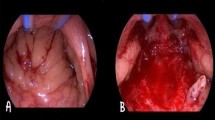Abstract
Tonsillotomy (TT) is now used more often than tonsillectomy (TE) for tonsil obstructive symptoms in Sweden. Both TE and TT give high patient satisfaction although TT results in fewer postoperative bleedings and shorter time when analgesics are needed. The objective of this study is to analyze the current prevalence of different tonsil surgery procedures, the rates of early and late bleeding and other complications. Data from the National Tonsil Surgery Register in Sweden were analyzed. Patients 1–15 years operated for symptoms due to tonsil hypertrophy were included. Surgical procedure, technique and bleedings during hospital stay were registered. Thirty days after surgery, unplanned contacts due to bleeding, infection or pain were reported as were symptom relief after 6 months. 24,083 patients were registered. Of the 10,826 children 1–15 years operated for obstructive symptoms, 64 % were TT or TT+A, and 34 % TE, TE+A. 69 % answered the 30-day questionnaire and 50 % the 6 months. Bleeding in hospital occurred in 1.38 %, late bleedings in 2.06 %: 3.7 % after TE+A, 0.8 % after TT+A. Differences in readmissions due to bleeding, number of days using analgesics, health care contacts due to pain and nosocomial infections were significant between TT and TE, but not differences with regard to symptom relief after 6 months.

Similar content being viewed by others
References
Van Den Akker EH et al (2004) Large international differences in (adeno) tonsillectomy rates. Clin Otolaryngol Allied Sci 29(2):161–164
Bhattacharjee R et al (2010) Adenotonsillectomy outcomes in treatment of obstructive sleep apnea in children: a multicenter retrospective study. Am J Respir Crit Care Med 182(5):676–683
Guilleminault C, Pelayo R (1998) Sleep-disordered breathing in children. Ann Med 30(4):350–356
Ericsson E, Hultcrantz E (2007) Tonsil surgery in youths: good results with a less invasive method. Laryngoscope 117(4):654–661
Hultcrantz E, Ericsson E (2004) Pediatric tonsillotomy with the radiofrequency technique: less morbidity and pain. Laryngoscope 114(5):871–877
Hultcrantz E, Linder A, Markstrom A (1999) Tonsillectomy or tonsillotomy?–A randomized study comparing postoperative pain and long-term effects. Int J Pediatr Otorhinolaryngol 51(3):171–176
Hessen Soderman AC et al (2011) Reduced risk of primary postoperative hemorrhage after tonsil surgery in Sweden: results from the National Tonsil Surgery Register in Sweden covering more than 10 years and 54,696 operations. Laryngoscope 121(11):2322–2326
Stalfors J et al (2012) Tonsil surgery efficiently relieves symptoms: analysis of 54,696 patients in the National Tonsil Surgery Register in Sweden. Acta Otolaryngol 132(5):533–539
Koempel JA, Solares CA, Koltai PJ (2006) The evolution of tonsil surgery and rethinking the surgical approach to obstructive sleep-disordered breathing in children. J Laryngol Otol 120(12):993–1000
de la Chaux R et al (2008) Tonsillotomy in the treatment of obstructive sleep apnea syndrome in children: polysomnographic results. Int J Pediatr Otorhinolaryngol 72(9):1411–1417
Gan K, Tomlinson C, El-Hakim H (2009) Post-operative bleeding is less after partial intracapsular tonsillectomy than bipolar total procedure. Int J Pediatr Otorhinolaryngol 73(5):667–670
Solares CA et al (2005) Safety and efficacy of powered intracapsular tonsillectomy in children: a multi-center retrospective case series. Int J Pediatr Otorhinolaryngol 69(1):21–26
Windfuhr JP et al (2008) Serious post-tonsillectomy hemorrhage with and without lethal outcome in children and adolescents. Int J Pediatr Otorhinolaryngol 72(7):1029–1040
Alhamarneh O, Raja H, England RJ (2008) Inadequate analgesic prescription increases secondary post-tonsillectomy bleed rates: a completed audit loop. J laryngol otol 122(7):719–721
Lowe D et al (2007) Key messages from the national prospective tonsillectomy audit. Laryngoscope 117(4):717–724
Doshi HK et al (2011) Age-related tonsillar regrowth in children undergoing powered intracapsular tonsillectomy. Int J Pediatr Otorhinolaryngol 75(11):1395–1398
Eviatar E et al (2009) Tonsillectomy vs. partial tonsillectomy for OSAS in children-10 years post-surgery follow-up. Int J Pediatr Otorhinolaryngol 73(5):637–640
Reichel O et al (2007) Tonsillotomy or tonsillectomy? a prospective study comparing histological and immunological findings in recurrent tonsillitis and tonsillar hyperplasia. Eur Arch Otorhinolaryngol 264(3):277–284
Ericsson E, Graf J, Hultcrantz E (2006) Pediatric tonsillotomy with radiofrequency technique: long-term follow-up. Laryngoscope 116(10):1851–1857
Koltai PJ et al. (2002) Intracapsular partial tonsillectomy for tonsillar hypertrophy in children. Laryngoscope 112(8 Pt 2 Suppl 100):17–9
Author information
Authors and Affiliations
Corresponding author
Rights and permissions
About this article
Cite this article
Hultcrantz, E., Ericsson, E., Hemlin, C. et al. Paradigm shift in Sweden from tonsillectomy to tonsillotomy for children with upper airway obstructive symptoms due to tonsillar hypertrophy. Eur Arch Otorhinolaryngol 270, 2531–2536 (2013). https://doi.org/10.1007/s00405-013-2374-7
Received:
Accepted:
Published:
Issue Date:
DOI: https://doi.org/10.1007/s00405-013-2374-7




